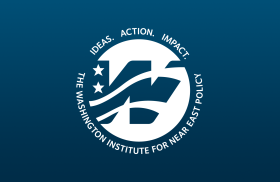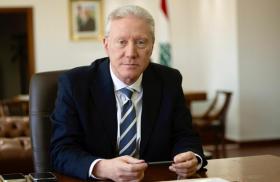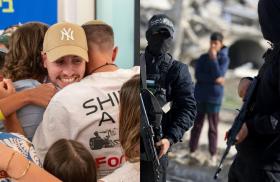
- Policy Analysis
- Fikra Forum
The Importance of Regional Diplomacy for Syria’s Druze

The recent flare-up of violence in southern Syria has once again exposed the fragility of the country’s post-Assad order and minority communities’ underlying fears that the current government is unwilling or incapable of establishing a government that ensures minority rights or ensuring the safety of all Syrians against militia factions.
For the Druze community in particular, the recent clashes represent a deeper disorder in the new Syria: the community’s past experiences have created a well-founded fear of the combination of a weak central government, emboldened militias, and a regional and international hesitancy to impose meaningful accountability, with the recent outbreak of violence in the Syrian coast and the subsequent massacres perpetrated against the Alawites serving as a case in point. Many in the Druze community, both within and outside of Syrian borders, fear that unless proactive diplomatic engagement is undertaken, Syria’s minorities—chief among them the Druze—will bear the brunt of this instability and become a convenient scapegoat.
Such fears complicate the glimpse of hope widespread among Syrians after the fall of the Assad regime, long dismissed as a pipe dream. Yet President Ahmad al-Sharaa, a former jihadist-turned-politician, has yet to bring the cohesion or legitimacy to a fractured and war-scarred nation. In recent weeks, a deadly clash between Druze fighters and the government-affiliated militias in the Damascus suburb of Sehnaya and Jarmana sparked protests and retaliatory attacks, renewing fears among Druze of state-sanctioned targeting of minorities. And when the Druze community looks to Damascus, many fear Sharaa’s inability—or unwillingness—to rein in rogue security forces, which has already resulted in indiscriminate violence, including in majority-Druze areas such as Suwayda, Jaramana, and Shahba.
The Druze of Syria, a historically marginalized yet politically adept community, have maintained a strategic neutrality throughout much of the Syrian conflict, a policy developed as a calculated survival strategy rather than passive disengagement. For the majority of the Syrian revolution against Assad, the Druze refrained from fully investing in either the rebels or Assad and were instead careful their use of violence, which was always framed as self-defense. And as Sharaa’s forces have sought to consolidate power under a new transitional government, significant portions—though not all—of the Druze leadership have remained wary, refusing to fully integrate into the new political and military apparatus. This reluctance is not born of sectarian intransigence, but of fears that Syria is sliding from authoritarianism into a new form of extremism—one cloaked in the language of reform but operating with the same repressive instincts.
This skepticism is rooted in recent history. The Druze leadership, particularly in Suwayda, has consistently voiced its discontent with Syria’s political situation while emphasizing a desire to remain part of a unified Syria. In particular, Sheikh Hikmat al-Hijri—one of the three spiritual leaders of the Druze community—has openly criticized both the Assad regime and its successor for failing to protect minority rights and for allowing foreign militias to entrench themselves in the country. In a notable sermon earlier this year, Hijri warned against “a new tyranny wearing revolutionary clothing,” urging young Druze to defend their towns but refrain from aligning with any faction that doesn’t prioritize Syria’s unity and sovereignty.
This internal resistance has manifested in practical ways. Many grassroots Druze militias have refused to disarm or be integrated into Sharaa’s military forces, and have accused government forces of corruption and sectarian targeting. Tensions came to a head last week when Druze fighters were ambushed near Sehnaya, allegedly by a pro-government unit. The ensuing firefight and subsequent security raids on Druze neighborhoods have exacerbated fears in this community of a campaign to intimidate it into submission.
Yet despite this mounting pressure, Hijri and his supporters have remained steadfast in their demands: autonomy in local governance, protection from external militias, and a non-token seat at the table in any political reconstruction effort. These demands in fact align with the principles laid out by the international community during previous rounds of Syrian peace talks.
It is due to this belief in the alignment between their demands and the expectations of the international community that the Syrian Druze leadership has called for diplomacy stepping in to mediate relations with Damascus and protect minority rights in Syria. The broader Druze community has also expressed deep concerns and made efforts to promote regional involvement. Israeli Druze leaders have publicly called on their government to protect their Syrian kin, while Druze political figures in Lebanon—though divided—have urged Beirut to voice support for Druze autonomy in Syria.
Given Damascus’s clear interest in international legitimacy, there are a number of mediators potentially palatable to both sides. The United States, despite its reduced military footprint in Syria, retains significant diplomatic leverage. But equally important are regional actors like Jordan—which shares deep tribal ties with the Druze and has historically played a stabilizing role in southern Syria—and the United Arab Emirates, which has positioned itself as a broker of minority rights and post-conflict reconstruction and of course the Kingdom of Saudi Arabia.
These actors can provide a focus on de-escalation and confidence-building between the central government and peripheral communities like the Druze. Most immediate concerns include demilitarizing tense zones where Druze and other militias might clash, halting arbitrary arrests, and mediating between community leaders and state actors. An Arab-led initiative, perhaps under the auspices of the Arab League or in coordination with the UN, could likewise open channels for local dialogues that prioritize inclusive governance and minority representation while addressing the central government’s fears that too much decentralization will lead to a fractured security situation.
Engagement with Damascus on these issues also allows for regional recognition and access to reconstruction funds to be conditioned on tangible reforms more broadly sought by Syria’s minority communities—including safeguards for these communities, decentralization of administrative powers, and legal protections for religious and ethnic groups—details which the Syrians are capable of debating and agreeing upon.
The alternative—neglect and disengagement—has proven disastrous before, and the region is riddled with cases demonstrating that when sectarian tensions are ignored, they metastasize. Leaving Syria’s Druze to navigate this brewing impasse themselves could not only the humanitarian crisis in the south, but also create fertile ground for Iranian militias, Hezbollah, or remnants of ISIS to exploit local grievances. Already, there are reports of Iranian-aligned groups attempting to infiltrate southern Syria under the guise of offering protection, a development that could further destabilize the region and threaten Israel’s northern border.
What is crucial is addressing these challenges before a more extensive clash occurs. The new Syria is at another crossroads, and successfully navigating the tensions between Damascus and the rest of Syria, such as Suwayda, is key to ensuring that Syria’s future does not resemble its recent past. Moreover, establishing a successful framework for navigating relations between Damascus and the Druze community can have ripple effects among other groups that are likewise wary of the central government’s ability to recognize and accommodate minority rights, and to ensure that diplomacy rather than military action dictates these new relations.
In order to ensure that Syria finds this alternative, a coordinated regional approach is both morally imperative and geopolitically sound. The manner in which the current standoff will be resolved will set a precedent in the future of Syria and thus provides an opportunity for both regional actors and interested parties such as the United States for working towards a future of a stable Syria.



